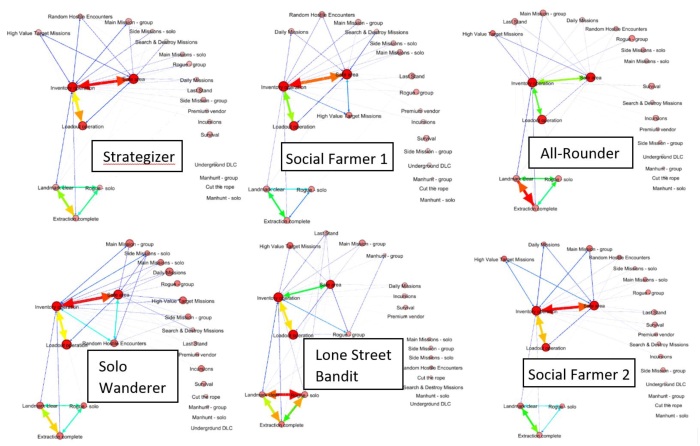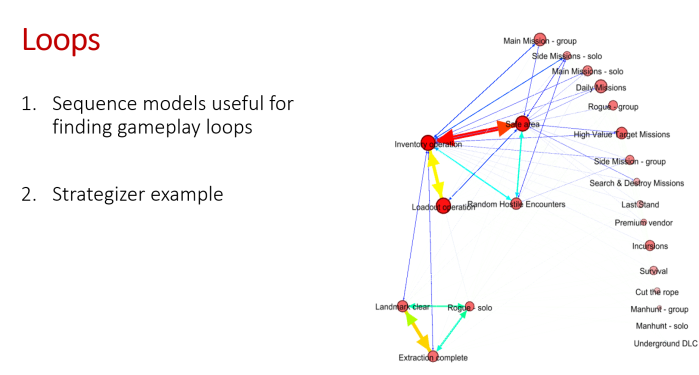In modern game development, it is crucial that we can place our players into sets of groups, where everyone in those groups shares specific traits. Without being able to do this, our ability to understand who the players are, and how they play our games, is hampered. The ability to profile the players is important because different groups of players react differently to the same stimulus, and behave differently within the confines of the same game. We need to understand these differences so we can deliver the best possible user experience to the players.
“When faced with overwhelming data about users, adopt the standpoint of condensing the data into a format where they are useful to you. Profiling is one such tool. This requires identifying the right data to work with and sacrificing detail, but can be a great way to enable taking action on user behavior.” (Drachen, 2016)
Going back a decade or more, we relied on basic segmentation as the way to try and get a handle on the diversity of player behaviors. Essentially, we would divide the user base into groups of individuals that were similar in specific ways. The player traits we looked at would be informed by the stakeholder requesting the analysis, rather than informed by the behavioral data that might be available.
Since we introduced telemetry systems in our games we have been able to create more accurate descriptions by investigating behavior, usage and habits of a population in a game. However, to a large degree, the segmentation of players is still based on aggregate information. For example, player X has killed Y opponents. Alternatively, we use average values across the whole population of players. Such numbers are from the perspective of the designers of contemporary major commercial titles almost meaningless. These statistics become actionable only if they are delivered for a specific group. For example, it could be expected that a population of risk-taking players have a high death rate. If the same happens to conservative players, it can be symptomatic of imbalances in the game. Behavioral profiling has been introduced in recent years as a means for building more accurate and actionable groups of players.
There are currently a wealth of different models being employed across academia and industry. Unfortunately, very few of these are productized to a significant degree.
Furthermore, a lot of the profiling work out there still works with aggregate data, and capture only snapshots of the player behavior. These are not always useful to design teams, but rather useful for informing strategic business decisions. While much more complex and information-rich profiling techniques exist, which include for example psychological information about the players, these are much less integrated in the industry and much less investigated in academia. That being said, behavioral profiling is attractive as a means for building a better understanding of our players and how to find out what they are interested in. This because these techniques allow us to consider them in a quantifiable way, using telemetry data.
Today, major commercial titles can track hundreds if not thousands of behavioral metrics from each player, on a continual basis as they progress in a title. Given the raw variance space such telemetry data create, we need tools to condense these behaviors into formats that showcase the patterns in the data. We also need tools that refine these patterns into a format where we can utilize them.
Case Study: Building Dynamic Player Profiles for Tom Clancy’s The Division
For this project, our goal was simple: we wanted to figure out how we could make behavioral modeling actionable to designers of major commercial titles. The project was spearheaded by the analytics team at Massive Entertainment, a part of Ubisoft, with additional help from the Ubisoft Montreal team. Additionally, researchers from the University of York and New York University participated. Together, we developed a methodologically simple framework for addressing this problem.
Our case study was Tom Clancy’s The Division, Massive Entertainments flagship title, a game with over 20 million players. It is an online shooter game with a persistent world and an ongoing history. The gameplay is complex, and players have a lot of agency in determining how to play the game. As something fairly unique in games research, we had analysts, researchers and the design team of the game working directly together. This gave us the ability to not only develop models in collaboration with the design team of a major commercial title, but also to validate proposed models, and ensure the usefulness of the developed profiles.
As mentioned, the current standard in behavioral profiling is to do snapshot profiling. Snapshot profiling focuses on the game as it is right now, and is commonly reliant on aggregated variables over the lifetime of the players, or for a short temporal window. Snapshot profiling is useful for understanding the state of the player right now and how the game is currently being played. It is also a useful technique for keeping a watch out on the community to detect problems and building warning systems. An old example of snapshot profiling is this one, were we used Simplex Volume Maximization, to identify seven clusters, or behavioral profiles, on a dataset captured from a limited time period from the game Battlefield 2. These were labelled and a description developed for each.
We can from these profiles extract useful information about how people are playing the game at the time of the analysis. Essentially, each of these profiles is an profile is an expression of a playstyle, and it allows us to draw some inference about player interest also. For example, the ”Driver” profile: drives, flies, sails – all the time and favors maps with vehicles. The ”Assassin”: kills – afar or close – but never uses vehicles, even on very large maps. Tend to favor small maps. The ”Target dummy” are the unskilled novices and they have a high dropout rate unless they quickly transfer to another cluster. However, as mentioned, snapshot profiles have limited shelf life, because players change their behaviour. What this means is that we do not play the same game in the same way, throughout our whole interaction history with the game. Here is a concrete example of this from the open-world action game Just Cause 2: The middle diagram shows the number of behavioural profiles, here determined using Archetype Analytics, that players changed between as they played through the game.This is visualized also to the right with a Sankey Flow Chart, which shows an example of 3 missions in the game, and how the players changed behaviour even across just a few main missions.
To solve this problem we need to use dynamic profiling. Dynamic profiling tries to take into account the historical information of the players. There are a lot of approaches, but in our case we decided to focus on the sequences of player behavior. In this we were inspired by DNA chains, where the ordering of individual nucleotides is incredibly important. The reason is simple: games are played and experienced sequentially. We therefore looked for a way to retain that ordering while also trying to condense the massive variance space in The Division into some more manageable profiles.
In building our methodological framework we specifically wanted to address on of the most prevalent problems in game analytics, namely the lack of actionability from analytics results, and the challenge of integrating the stakeholders in the analytical process. Our core idea with the project was thus relatively simple: Can we present The Division’s design team with sequences of behavior that characterized groups of players, and could those sequences inform designers about how the game was being played? In addition, we were interested in the action sequences of the players before events of interest. For example, are there particular sequences of behavior that come right before players stop playing?
n the beginning, we worked with the design team of The Division – across game-, level- and system designers, to identify the kinds of player activities or events that were meaningful to them. We ran a workshop where we identified what kinds of activities, when presented as a sequence, would be something the design team could pick up and utilize. Activities or events could be things like starting a particular type of mission, or regrouping with a team in a safe house. Through the workshop we established a list of 22 player activities, that was expanded by including modifiers such as whether the activity was carried out in groups or alone, as well as the difficulty setting at the time. In this way we ended up with 52 activities. We then engineered metrics for each of these, and extracted the relevant data from about 10,000 randomly selected players, who played across March-April 2017. Following, we used Sequential Pattern mining (via the CM-SPAM package) to identify sequences of recurrent behavior. We accepted no gaps between activities, and ended up with 826 sequences above the support cutoff.
We then applied Shannon Entropy to identify the most information-rich sequences. This is a step that can be ignored, but helps identify potentially useful sequences. We then used cross-correlation to detect sequences that were similar. We then checked the results with the design team, verifying that the collapsing of similar sequences made sense to them. We then applied different cluster models on the sequences, ending up with AGNES/Ward for its component resolution, giving us six behavioral profiles, characterized by these sequences. Cluster analysis on player behavior has to be carefully approached, as the choice of model can have implications for what results we end up with. In this case Ward’s method gave us a reasonable breakdown and we used for example elbow plots to build confidence about our choice of number of clusters.
In a third workshop with the design team, both sequence-based and traditional aggregate-based behavioral profiles were presented to the team. The sequence-based models proved highly popular, and led the team to implement changes to the design of the game. Here are the six profiles: The 6 sequence-based clusters are represented as network graphs. Nodes represent the 22 basic activities, edges represent movements between activities. The color and thickness of the arrows indicate how often players in that cluster proceed from one action to the next; and the size and color of the nodes represents the frequency of that activity.
The profiles are characterized by specific sequences of behavior. For example, the Lone Street Bandits engage in the rogue solo – extraction – solo – rogue solo sequence, which represents a specific form of solo play. The Social Farmers on the other hand move from random hostile encounters to side missions and occasionally main missions, but always as a group. What we found was that sequence-based behavioral profiles can be used by game designers to find the gameplay loops, i.e. repeated patterns in player behavior, used by groups of players. These loops are particularly useful in informing design, as they allow designers to understand how players move between favorite activities, not just the frequency of these activities.
As an example, the Strategizer cluster tend to follow the loop “safe area – inventory operation – loadout operation”, with the ladder having high target value missions, which are difficult and shows a high degree of intentionality – the Strategizers are carefully selecting these missions for their potential payout.
Sequence-based profiles are not only useful to understand how users play the game, and whether that behavior matches was the designers intended, but also for understanding the sequences and loops leading up to desired or undesired events, e.g. a player buying an item or stopping to play the game. Furthermore, such models can be used to inform match-making between players, by showing us their preferred activities. It is also worth noting that the domain knowledge of the design team was crucial to the usefulness of the result. This is a recurrent lesson in business intelligence research. On a final note, methodologically, our work with The Division is straightforward and can be adapted to other games. Indeed this is among the main goals of our current work at Massive Entertainment.
See also the below case studies on behavioral profiling in games
Player Modeling using Self-Organization in Tomb Raider: Underworld
 We present a study focused on constructing models of players for the major commercial title Tomb Raider: Underworld (TRU). Emergent self-organizing maps are trained on high-level playing behavior data obtained from 1365 players that completed the TRU game. The unsupervised learning approach utilized reveals four types of players which are analyzed within the context of the game. In this paper, we present a study focused on constructing models of players for the major commercial title Tomb Raider: Underworld (TRU). Emergent self-organizing maps are trained on high-level playing behavior data obtained from 1365 players that completed the TRU game. The unsupervised learning approach utilized reveals four types of players which are analyzed within the context of the game. The proposed approach automates, in part, the traditional user and play testing procedures followed in the game industry since it can inform game developers, in detail, if the players play the game as intended by the game design. Subsequently, player models can assist the tailoring of game mechanics in real-time for the needs of the player type identified. See also this excellent historical writeup about the impact of some of the earliest work in Game Analytics that was supported by Square Enix.
We present a study focused on constructing models of players for the major commercial title Tomb Raider: Underworld (TRU). Emergent self-organizing maps are trained on high-level playing behavior data obtained from 1365 players that completed the TRU game. The unsupervised learning approach utilized reveals four types of players which are analyzed within the context of the game. In this paper, we present a study focused on constructing models of players for the major commercial title Tomb Raider: Underworld (TRU). Emergent self-organizing maps are trained on high-level playing behavior data obtained from 1365 players that completed the TRU game. The unsupervised learning approach utilized reveals four types of players which are analyzed within the context of the game. The proposed approach automates, in part, the traditional user and play testing procedures followed in the game industry since it can inform game developers, in detail, if the players play the game as intended by the game design. Subsequently, player models can assist the tailoring of game mechanics in real-time for the needs of the player type identified. See also this excellent historical writeup about the impact of some of the earliest work in Game Analytics that was supported by Square Enix.
Controlling the Crucible: A PvP Recommender Systems Framework for Destiny
Compared to conventional retail games, today’s Massively Multiplayer Online Games have become progressively more complex. Consumable resources in such games are nearly unlimited, making decisions to improve levels of engagement more challenging.Intelligent information filtering methods here can help players make smarter decisions, thereby improving performance, increasing engagement, and reducing the likelihood of early departure. In this paper, a novel approach towards building a hybrid content- and knowledge-based recommender system for player-versus-player (PvP) content in the Destiny is presented. The frame-work groups the players based on three distinct traced behavioral aspects: base stats, cooldown stats, and weapon playstyle. Different combinations of these pro-files are considered to make playstyle recommendations and online evaluations through the social community website Reddit are made to evaluate the performance of the framework.
Guns, Swords and Data: Clustering of Player Behavior in Computer Games in the Wild
 Behavioral data from computer games can be exceptionally high-dimensional, of massive scale and cover a temporal segment reaching years of real-time and a varying population of users. Clustering of user behavior provides a way to discover behavioral patterns that are actionable for game developers. Behavioral data from computer games can be exceptionally high-dimensional, of massive scale and cover a temporal segment reaching years of real-time and a varying population of users. Clustering of user behavior provides a way to discover behavioral patterns that are actionable for game developers. Interpretability and reliability of clustering results is vital, as decisions based on them affect game design and thus ultimately revenue. In this paper, case studies are presented focusing on clustering analysis applied to high-dimensionality player behavior telemetry, covering a combined total of 260,000 characters from two major commercial game titles: the Massively Multiplayer Online Role-Playing Game Tera and the multi-player strategy war game Battlefield 2: Bad Company 2.Kmeans and Simplex Volume Maximization clustering were applied to the two datasets, combined with considerations of the design of the games, resulting in actionable behavioral profiles. Depending on the algorithm different insights into the underlying behavior of the population of the two games are provided.
Behavioral data from computer games can be exceptionally high-dimensional, of massive scale and cover a temporal segment reaching years of real-time and a varying population of users. Clustering of user behavior provides a way to discover behavioral patterns that are actionable for game developers. Behavioral data from computer games can be exceptionally high-dimensional, of massive scale and cover a temporal segment reaching years of real-time and a varying population of users. Clustering of user behavior provides a way to discover behavioral patterns that are actionable for game developers. Interpretability and reliability of clustering results is vital, as decisions based on them affect game design and thus ultimately revenue. In this paper, case studies are presented focusing on clustering analysis applied to high-dimensionality player behavior telemetry, covering a combined total of 260,000 characters from two major commercial game titles: the Massively Multiplayer Online Role-Playing Game Tera and the multi-player strategy war game Battlefield 2: Bad Company 2.Kmeans and Simplex Volume Maximization clustering were applied to the two datasets, combined with considerations of the design of the games, resulting in actionable behavioral profiles. Depending on the algorithm different insights into the underlying behavior of the population of the two games are provided.
A Team Based Player Versus Player Recommender Systems Framework For Player Improvement
Modern Massively Multi-player Online Games (MMOGs) have grown to become extremely complex in terms of the usable resources in the games, resulting in an increase in the amount of data collected by tracking the in-game activities of players. This has opened the door for researchers to come up with novel methods to utilize this data to improve and personalize the user experience. In this paper, a novel but flexible framework towards building a team based recommender system for player-versus-player (PvP) content in such MMOGs is presented, and applied to a case study in the context of the major commercial title Destiny 2. The framework combines behavioral profiling via cluster analysis with recommendation systems to look at teams of players as a unit, as well as the individual players, to make recommendations to the players, with the purpose of providing information to them towards improving their performance.
Clustering Game Behavior Data
 Recent years have seen a deluge of behavioral data from players hitting the game industry. Reasons for this data surge are many and include the introduction of new business models, technical innovations, the popularity of online games, and the increasing persistence of games. Irrespective of the causes, the proliferation of behavioral data poses the problem of how to derive insights therefrom. Behavioral data sets can be large, time-dependent and high-dimensional. Clustering offers a way to explore such data and to discover patterns that can reduce the overall complexity of the data. Clustering and other techniques for player profiling and play style analysis have therefore become popular in the nascent field of game analytics. However, the proper use of clustering techniques requires expertise and an understanding of games is essential to evaluate results. With this paper, we address game data scientists and present a review and tutorial focusing on the application of clustering techniques to mine behavioral game data. Several algorithms are reviewed and examples of their application shown. Key topics such as feature normalization are discussed and open problems in the context of game analytics are pointed out.
Recent years have seen a deluge of behavioral data from players hitting the game industry. Reasons for this data surge are many and include the introduction of new business models, technical innovations, the popularity of online games, and the increasing persistence of games. Irrespective of the causes, the proliferation of behavioral data poses the problem of how to derive insights therefrom. Behavioral data sets can be large, time-dependent and high-dimensional. Clustering offers a way to explore such data and to discover patterns that can reduce the overall complexity of the data. Clustering and other techniques for player profiling and play style analysis have therefore become popular in the nascent field of game analytics. However, the proper use of clustering techniques requires expertise and an understanding of games is essential to evaluate results. With this paper, we address game data scientists and present a review and tutorial focusing on the application of clustering techniques to mine behavioral game data. Several algorithms are reviewed and examples of their application shown. Key topics such as feature normalization are discussed and open problems in the context of game analytics are pointed out.
The Trails of Just Cause 2: Spatio-Temporal Player Profiling in Open-World Games
Behavioral profiling of players in digital games is a key challenge in game analytics, representing a particular challenge in Open-World Games. These games are characterized by large virtual worlds and few restrictions on player affordances. In these games, incorporating the spatial and temporal dimensions of player behavior is necessary when profiling behavior, as these dimensions are important to the playing experience. We present analyses that apply cluster analysis and the DEDICOM decompositional model to profile the behavior of more than 5,000 players of the major commercial title Just Cause 2 integrating both spatio-temporal trails and behavioral metrics. The application of DEDICOM to profile the spatio-temporal behavior of players is demonstrated for the purpose of analysing the entire play history of Just Cause 2 players, but also for the more detailed analysis of a single mission. This showcases the applicability of spatio-temporal profiling to condense player behavior across large sample sizes, across different scales of investigation. The method presented here provides a means to build profiles of player activity in game environments with high degrees of freedom across different scales of analysis – from a small segment to the entire game.
Behavior Evolution in Tomb Raider Underworld
 Behavioral datasets from major commercial game titles of the “AAA” grade generally feature high dimensionality and large sample sizes, from tens of thousands to millions, covering time scales stretching into several years of real-time, and evolving user populations. This makes dimensionality-reduction methods such as clustering and classification useful for discovering and defining patterns in player behavior. The goal from the perspective of game development is the formation of behavioral profiles that provide actionable insights into how a game is being played, and enables the detection of e.g. problems hindering player progression. Due to its unsupervised nature, clustering is notably useful in cases where no prior-defined classes exist. Previous research in this area has successfully applied clustering algorithms to behavioral datasets from different games. In this paper, the focus is on examining the behavior of 62,000 players from the major commercial game Tomb Raider: Underworld, as it unfolds from the beginning of the game and throughout the seven main levels of the game. Where previous research has focused on aggregated behavioral datasets spanning an entire game, or conversely a limited slice or snapshot viewed in isolation, this is to the best knowledge of the authors the first study to examine the application of clustering methods to player behavior as it evolves throughout an entire game.
Behavioral datasets from major commercial game titles of the “AAA” grade generally feature high dimensionality and large sample sizes, from tens of thousands to millions, covering time scales stretching into several years of real-time, and evolving user populations. This makes dimensionality-reduction methods such as clustering and classification useful for discovering and defining patterns in player behavior. The goal from the perspective of game development is the formation of behavioral profiles that provide actionable insights into how a game is being played, and enables the detection of e.g. problems hindering player progression. Due to its unsupervised nature, clustering is notably useful in cases where no prior-defined classes exist. Previous research in this area has successfully applied clustering algorithms to behavioral datasets from different games. In this paper, the focus is on examining the behavior of 62,000 players from the major commercial game Tomb Raider: Underworld, as it unfolds from the beginning of the game and throughout the seven main levels of the game. Where previous research has focused on aggregated behavioral datasets spanning an entire game, or conversely a limited slice or snapshot viewed in isolation, this is to the best knowledge of the authors the first study to examine the application of clustering methods to player behavior as it evolves throughout an entire game.
Patterns of Play: Play-Personas in User-Centred Game Development
 In recent years certain trends from User-Centered design have been seeping into the practice of designing computer games. The balance of power between game designers and players is being renegotiated in order to find a more active role for players and provide them with control in shaping the experiences that games are meant to evoke. A growing player agency can turn both into an increased sense of player immersion and potentially improve the chances of critical acclaim. This paper presents a possible solution to the challenge of involving the user in the design of interactive entertainment by adopting and adapting the “persona” framework introduced by Alan Cooper in the field of Human Computer Interaction. The original method is improved by complementing the traditional ethnographic descriptions of personas with parametric, quantitative, data-oriented models of patterns of user behaviour for computer games.
In recent years certain trends from User-Centered design have been seeping into the practice of designing computer games. The balance of power between game designers and players is being renegotiated in order to find a more active role for players and provide them with control in shaping the experiences that games are meant to evoke. A growing player agency can turn both into an increased sense of player immersion and potentially improve the chances of critical acclaim. This paper presents a possible solution to the challenge of involving the user in the design of interactive entertainment by adopting and adapting the “persona” framework introduced by Alan Cooper in the field of Human Computer Interaction. The original method is improved by complementing the traditional ethnographic descriptions of personas with parametric, quantitative, data-oriented models of patterns of user behaviour for computer games.











